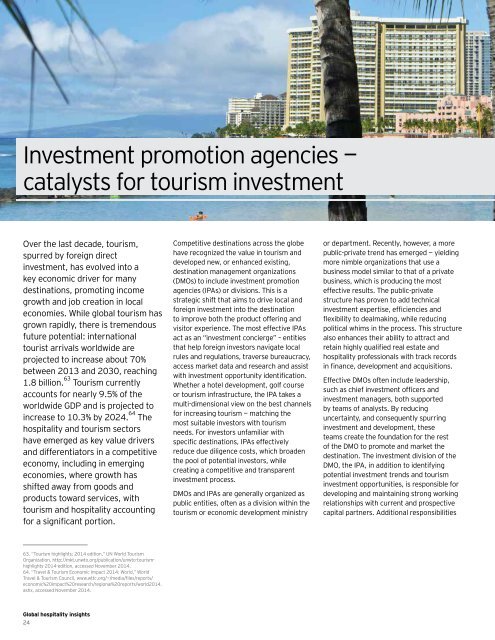ey-global-hospitality-insights-2015
ey-global-hospitality-insights-2015
ey-global-hospitality-insights-2015
Create successful ePaper yourself
Turn your PDF publications into a flip-book with our unique Google optimized e-Paper software.
Investment promotion agencies —catalysts for tourism investmentOver the last decade, tourism,spurred by foreign directinvestment, has evolved into ak<strong>ey</strong> economic driver for manydestinations, promoting incomegrowth and job creation in localeconomies. While <strong>global</strong> tourism hasgrown rapidly, there is tremendousfuture potential: internationaltourist arrivals worldwide areprojected to increase about 70%between 2013 and 2030, reaching1.8 billion. 63 Tourism currentlyaccounts for nearly 9.5% of theworldwide GDP and is projected toincrease to 10.3% by 2024. 64 The<strong>hospitality</strong> and tourism sectorshave emerged as k<strong>ey</strong> value driversand differentiators in a competitiveeconomy, including in emergingeconomies, where growth hasshifted away from goods andproducts toward services, withtourism and <strong>hospitality</strong> accountingfor a significant portion.Competitive destinations across the globehave recognized the value in tourism anddeveloped new, or enhanced existing,destination management organizations(DMOs) to include investment promotionagencies (IPAs) or divisions. This is astrategic shift that aims to drive local andforeign investment into the destinationto improve both the product offering andvisitor experience. The most effective IPAsact as an “investment concierge” – entitiesthat help foreign investors navigate localrules and regulations, traverse bureaucracy,access market data and research and assistwith investment opportunity identification.Whether a hotel development, golf courseor tourism infrastructure, the IPA takes amulti-dimensional view on the best channelsfor increasing tourism — matching themost suitable investors with tourismneeds. For investors unfamiliar withspecific destinations, IPAs effectivelyreduce due diligence costs, which broadenthe pool of potential investors, whilecreating a competitive and transparentinvestment process.DMOs and IPAs are generally organized aspublic entities, often as a division within thetourism or economic development ministryor department. Recently, however, a morepublic-private trend has emerged — yieldingmore nimble organizations that use abusiness model similar to that of a privatebusiness, which is producing the mosteffective results. The public-privatestructure has proven to add technicalinvestment expertise, efficiencies andflexibility to dealmaking, while reducingpolitical whims in the process. This structurealso enhances their ability to attract andretain highly qualified real estate and<strong>hospitality</strong> professionals with track recordsin finance, development and acquisitions.Effective DMOs often include leadership,such as chief investment officers andinvestment managers, both supportedby teams of analysts. By reducinguncertainty, and consequently spurringinvestment and development, theseteams create the foundation for the restof the DMO to promote and market thedestination. The investment division of theDMO, the IPA, in addition to identifyingpotential investment trends and tourisminvestment opportunities, is responsible fordeveloping and maintaining strong workingrelationships with current and prospectivecapital partners. Additional responsibilities63. “Tourism highlights: 2014 edition,” UN World TourismOrganization, http://mkt.unwto.org/publication/unwto-tourismhighlights-2014-edition,accessed November 2014.64. “Travel & Tourism Economic Impact 2014: World,” WorldTravel & Tourism Council, www.wttc.org/~/media/files/reports/economic%20impact%20research/regional%20reports/world2014.ashx, accessed November 2014.Global <strong>hospitality</strong> <strong>insights</strong>24


